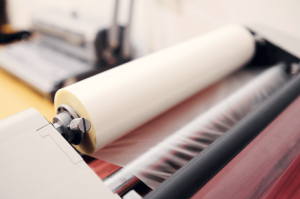When browsing through laminate films, you need to consider the laminator you’re using and your project. Separate machines come with their own requirements, so using the wrong supplies can ruin your machine and project. With films, there are lots of options to pick from. To help you prevent problems, we’re going to discuss several options and where to use them. Then, if you want professional laminating services, you can rely on us.
Thermal hot laminating film
 Let’s start with thermal laminators. They utilise a thermal laminating film. It features a heat-activated adhesive to secure the film. This is the standard laminate you’ll probably be familiar with, so most people know what to expect with it.
Let’s start with thermal laminators. They utilise a thermal laminating film. It features a heat-activated adhesive to secure the film. This is the standard laminate you’ll probably be familiar with, so most people know what to expect with it.
Uses for thermal laminating film vary massively. This is because all sorts of projects can put up with the high temperatures with hot roll laminators. You can use the films for legal documents, restaurant menus, and documents that are letter-size and bigger. Other uses include posters, ID and business cards, and banner and display graphics. However, keep in mind that not all banner materials are compatible with heat.
Low melt laminating film
What we have here is a solid middle-ground pick between cold and thermal lamination. Low melt film is for a type of thermal laminating. Although, it comes with a lower melting point and has two types of adhesive, not one. The fact you don’t need as much heat makes the films ideal for commercial artwork, digital prints, and some ink jet media.
Cold pressure-sensitive roll film
Cold roll laminators work with laminating roll made using pressure-sensitive adhesive. They don’t apply heat. As a result, they are perfect for any project involving temperature-sensitive inks. For example, they’re ideal for anything that could melt, get distorted, or has a coating. Examples include outdoor graphics needing UV protection and glossy photo media. Other applications are banners and signs, digital and ink jet prints, and artwork. Contact us if you need first rate laminating services.
Considerations
We’ll end by discussing some details you should consider with laminating film. One of the most important is finish. There are a few of these to choose from. Matte film for instance has zero glare and resists fingerprints. Just remember that it has a grainy texture. Such a film works for displays, artwork, and posters. As for standard glossy film, it’s shinier, and gives off brighter colours and sharper details. It’s a cost effective option for reports, ID cards, menus, and more.
Thickness is another consideration. You measure the thickness of laminate film in mils. One mil equals 1/1000ths of an inch. So, it’s very thin. Even though all films are thin, separate mil thicknesses have their own applications. To give an example, a 1.5 mil film is flexible and perfect for objects printed on heavy cardstock. With a 10 mil film, it’s very rigid and difficult to bend. It’s normally used for menus you don’t need to fold, reference sheets, and ID badges.
Lastly, there is width, length, and core size. These factors mainly apply to the kind of laminator you’re using. Some models come with the capacity to handle all sorts of core sizes and widths of lamination film. But, you need to be careful. Make sure your model can work with the film you want to use. With length, most films come with common standard lengths. For the rolls that have more options, you shouldn’t use too long of a roll. It could prove too big for the laminator.
Reliable laminating services for many needs
At Foiling Services, we have become an authority on how to best handle lamination. Due to how sensitive a process it is at times, we know to always be careful when working on your items. It ensures we deliver the most impressive results for every project.
So, if you’d like to experience our laminating services, please let us know. You can ask us about different applications, films, and more to ensure you get exactly what you want.
